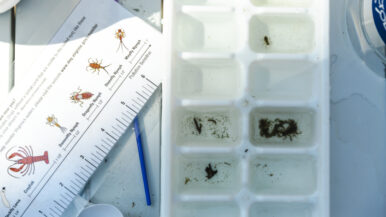Choose your experience:
Duration: 75 minutes
Did you know that migrating animals use many of the same navigational methods that humans do? Most migrating animals travel across large stretches of oceans and land annually, using their built-in GPS, mental maps, sound, and compasses.
During this program, students will compare and contrast animal and human navigation methods through hands-on STEM activities. Additionally, the program highlights endangered or threatened species found in the Chesapeake Bay and the human impacts on their migration. Students will put their navigational skills to the test creating mental maps, mimicking echolocation, and learning the basics of compasses. We end the program with a game that enhances the learned material.
Duration: 75 minutes
Did you know that migrating animals use many of the same navigational methods that humans do? Most migrating animals travel across large stretches of oceans and land annually, using their built-in GPS, mental maps, sound, and compasses.
During this program, students will compare and contrast animal and human navigation methods through hands-on STEM activities. Additionally, the program highlights endangered or threatened species found in the Chesapeake Bay and the human impacts on their migration. Students will put their navigational skills to the test creating mental maps, mimicking echolocation, and learning the basics of compasses. We end the program with a game that enhances the learned material.
Learning Objectives
Students will:
- Explore the basics of animal navigation and migration
- Discover how humans impact navigation and migration
- Learn why preserving habitats in and around the Chesapeake Bay watershed is important to animal migration, as well as what they can do to help.
Science (VDOE 2018):
- Elementary: 4.3 (a,c), 4.7 (c), 4.8 (a,b), 5.5 (a,b,c,d), 5.8 (a), 5.9 (a)
- Middle: 6.3 (a), 6.6 (f), 6.8 (a,b,c,d), 6.9 (a,b,e), LS.7 (b), LS.8 (a,b,c), LS.9 (a,b,c), LS.11 (a,c), PS.7 (a), PS.9 (b,d,f)
- High: BIO.7 (b), BIO.8 (d), ES.6 (c), ES.7 (a), ES.8 (c,d), ES.10 (a,e)
Next Generation Science Standards:
- Elementary: 4-PS3-2, 4-LS1-2, 4-ESS2-2, 5-ESS2-1, 5-ESS3-1, 3-5-ETS1-1, 3-5-ETS1-2Middle: MS-PS2-3, MS-LS1-8, MS-LS2-1, MS-LS2-4, MS-ESS2-4, MS-ESS3-3
- High: HS-LS2-7, HS-LS4-5,
Principles of Ocean Literacy:
- 1) The Earth has one big ocean with many features
- 2) The ocean and life in the ocean shape the features of the Earth
- 5) The ocean supports a great diversity of life and ecosystems
- 6) The oceans and humans are inextricably interconnected
Pricing:
Payment can be made before the program, or we can invoice following your program.
- Programs at the Museum are $4.50 per student.
All adults accompanying a field trip are free. - Programs at your location are $4.50 per student.
- Virtual education programs are $125 per program.
Reservations are required for all programs and are booked on a first-come, first-served basis. Programs fill quickly in the fall and spring, so make your reservations a minimum of two weeks in advance.
Need some questions answered?
Our team is happy to answer any questions you may have, or recommend the best program for your class.
Call or email our Education team:
[email protected]
(757) 591-7745





